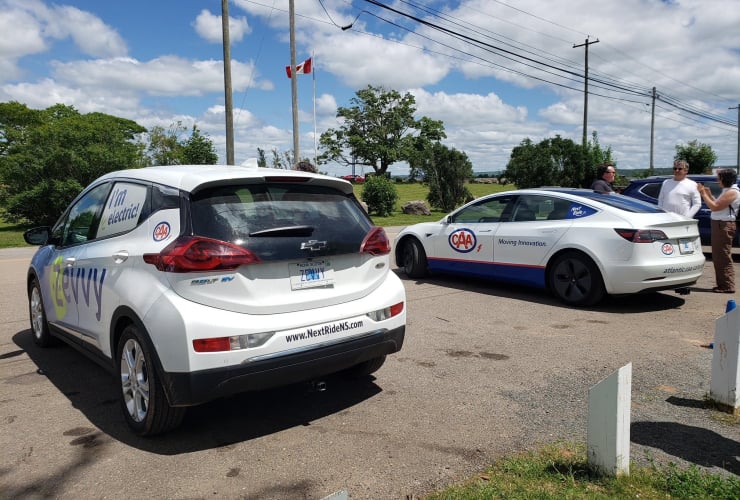Another Earth Day has come and gone. Delegates are in Ottawa this week to hammer out a global plastics treaty. These events happened against a backdrop of continued uncertainty about our commitment to fighting climate change. Carbon pricing, electric vehicles and other climate-friendly measures are taking a back seat to pocketbook issues such as affordability. This kind of short-term thinking is creating anxiety amongst young people and climate activists who desperately want to be more hopeful about the future. Perhaps some relief for climate anxiety can be found by imagining what the world would look like if we embraced these climate-friendly measures.
My vision begins with this scenario in Calgary in the year 2029.
Dust rises above a group of volunteers digging shovels and bare hands into fresh soil as they plant seedlings for Calgary’s latest community forest project in a field next to the Shepard Energy Centre north of the Calgary Ring Road. Boisterous chatter and the invigorating smell of fresh soil fill the air.
After retiring its Shepard electricity plant, Enmax converted the site into Canada’s first hybrid power plant with two gigawatts (GW) of solar capacity, 500 megawatts (MW) of geothermal and four GW-hours of energy storage. With this additional capacity, Alberta’s electricity grid is now over 90 per cent emissions-free.
The province also invested in a tenfold increase in its power-sharing capacity between Montana, Saskatchewan and British Columbia. Power-sharing between regions now satisfies peak demand when renewable capacity is low and avoids firing up the few remaining combined-cycle gas plants.
Calgary’s transit system has been fully electrified and the fuel cost savings put towards expanding service into a hub-and-spoke design that more efficiently uses the CTrain lines and shortens routes for electric buses.
The city is also continually expanding its cycle-track network to rival bike-friendly urban centres like Montreal and Vancouver. Bike lanes are bustling with e-scooters and e-bikes from April through October and many hardy souls continue to commute by bike year-round.
Over the years, the expected strain on the electricity grid never materialized as new building codes required solar panels on residential and commercial buildings, increased thermal insulation and heat pumps to help reduce air-conditioning demand in the hottest months of summer.
Smart meters and bidirectional electric vehicle chargers allow utilities to use vehicles and residential battery storage as virtual power plants when demand spikes. Despite a growing population, energy consumption is now lower than it was at the turn of the century.
As society struggled through what is now recognized as the last decade of the fossil fuel era, we reached an inflection point where global demand for polluting energy finally began to decline. Turmoil ensued in the oil markets and prices plummeted.
Industry panic was triggered by the bankruptcy of Chevron, one of the world’s largest petroleum companies, and Alberta experienced the biggest oil bust in its history. These were tough times for Albertans because little had been done to prepare for the global decline in petroleum demand.
Hard times spur transformation and the “great bust” kick-started a race to rebuild Alberta’s energy economy based on abundant wind and solar resources. Rural communities that once feared renewable energy now embraced the jobs, reliable revenues and increasing tax base.
After years of steadily rising temperatures, persistent drought and wildfire smoke, agricultural producers were ready for the lifeline offered by wind and solar companies. They’d also become increasingly frustrated with the oil industry as jobs vanished and the abandoned well count approached 400,000 sites, a massive cleanup liability for all Albertans.
It’s now apparent the oil and gas industry never had any intention of cleaning up its mess as profits evaporated and operations in the oilsands were shuttered. Corporations continue to walk away from their businesses, forcing the provincial government to become caretakers of a declining industry. This exodus is having a surprisingly positive result.
Without the financial resources to fund lobbyists, greenwashing campaigns and right-wing media corporations, it’s now much easier for federal and provincial governments to introduce climate-friendly policies. As political campaign funding dries up for oil-loving populist parties, support for climate action amongst conservatives is actually growing — and rapidly. Conservatives are seeing opportunities for new businesses and their traditional nature-friendly values are re-emerging.
We are in a golden era of regenerative dialogue. Extractive and polluting industries are regulated and their relentless consumption of resources is curtailed. Forestry companies are forced to adopt selective logging practices and plant diverse, regenerative ecosystems where clear-cutting is still allowed. Logging of old-growth forests is banned across the country.
Land has been returned to Indigenous communities, beginning with the land title agreement with the Haida Nation in 2024. As a result, an ecosystem services economy emerged, bringing new revenue and livelihoods in nature-based stewardship. Wildfires are declining in size and intensity as Indigenous communities assume responsibility for managing boreal forests. In Alberta, new microclimates are developing to restore the desiccated hydrologic cycle.
When green building standards were introduced, energy demand plummeted as strategically placed shade trees, living walls and rooftop gardens became standard features. Urban forestry budgets were doubled and the destructive cycle of tree loss reversed. All this greenery contributed to cleaner air and reduced urban heat islands that were becoming a health issue across the country.
As the world transitions to a more peaceful and co-operative society, it’s become apparent that much of the polarization was driven by a dying fossil industry fighting to preserve its wealth and power. All levels of government have now agreed to revise the Constitution to protect nature and prevent extractive industries from regaining a stranglehold on society.
As countries started working collaboratively on efforts to transition economies to prioritize ecosystem services, millions of acres of forest, grasslands, wetlands and mangroves were restored. A revolution in regenerative agriculture improved soil health and prevented the demise of a food system that had been reaching a breaking point as the planet heated to unsustainable levels.
Our world still isn’t perfect, but it finally feels like a catastrophe has been avoided. Everything is recovering rapidly, including our relationships with each other. Children no longer experience despair when they learn about global warming because we can point to all the progress being made. It may take centuries to get back to the pristine world we once had, but we’re finally on a path that will take us there.
You may feel like this utopian outcome is impossible to achieve, but we have all the required knowledge and solutions right now. We can decide which future we will build. Do we want to continue building fossil fuel infrastructure and increasing our carbon pollution or is the utopian vision something worth striving for? National Hockey League great Wayne Greztky once said, “You miss 100 per cent of the shots you don’t take.”
Rob Miller is a retired systems engineer, formerly with General Dynamics Canada, who now volunteers with the Calgary Climate Hub and writes on behalf of Eco-Elders for Climate Action, but any opinions expressed in his work are his own.
Thank you for this. I think
Thank you for this. I think collectively we need to spend more time and effort on envisioning the kind of future that we want and articulating this to others.
I agree with Patricia. We as
I agree with Patricia. We as a society need to spend much more time and energy putting meat on the bones of an ecological vision. Something to generate enthusiasm. An essential antidote to the hate and fear being generated by our populist politicians and press. Our young people deserve to have hope.
Let’s see the National Observer start a series or recurring stories on healthy ways to restore our home. With concrete details that make the possibilities come alive.
It’s all very well to be critical of the stupidities of our people in power. And necessary. But let’s start describing healthy futures in a way that will encourage us.
"My vision begins with this
"My vision begins with this scenario in Calgary in the year 2029."
2029 or 2129? Even utopian visions need to be realistic.
2029 is five years away.
Amid growing hostility, Calgary's progressive climate-aware mayor will probably be run out of town before then.
"the last decade of the fossil fuel era"
"operations in the oilsands were shuttered"
Hardly. Even if fossil fuel use peaks this decade, the peak will be followed by a slow decades-long plateau, not a precipitous drop-off.
"Turmoil ensued in the oil markets and prices plummeted. … Alberta experienced the biggest oil bust in its history. "
Leaving massive holes in provincial budgets. Not something Alberta can recover from in five years.
Alberta is likely to descend into further chaos. Destabilizing government.
As we saw in the Notley era, Albertans will focus their fear and rage on the government. If Nenshi is at the helm, he will not last long. Expect an even bigger swing to the right — and even more radical extremism.
Indigenous communities who foolishly hitched their wagons to the O&G industry will require federal bailouts. As we saw during the pandemic and simultaneous OPEC-Russia price war.
"forcing the provincial government to become caretakers of a declining industry"
A provincial government facing massive budget cuts will be in no position to cover O&G liabilities. This burden will fall to Ottawa — federal taxpayers.
Alberta may emerge as the biggest winner of equalization yet.
"avoids firing up the few
"avoids firing up the few remaining combined-cycle gas plants"
Alberta has a for-profit, free-enterprise, deregulated system — "Canada's only truly competitive wholesale electricity market". Not a crown corporation.
Who owns the "few remaining combined-cycle gas plants" if they are running only part of the time and are therefore unprofitable? Who builds them in future?
"Forestry companies are forced to adopt selective logging practices and plant diverse, regenerative ecosystems where clear-cutting is still allowed."
Huh?
"Wildfires are declining in size and intensity as Indigenous communities assume responsibility for managing boreal forests."
As the planet heats up due to cumulative global GHG emissions, under extreme fire conditions humans cannot stop massive forest fires in remote regions — a positive feedback for warming. No amount of forest management, even if it were feasible, can stop this. Wildfires are likely to get worse for decades until forests fail to regenerate.
"Urban forestry budgets were doubled and the destructive cycle of tree loss reversed."
As southern Alberta becomes increasingly dessicated, how many trees will Calgary and regions further south support?
Southern Alberta's water problems are only going to multiply. Even Northern Alberta is already grappling with drought.
As glaciers disappear, late-summer river flows will shrink.
Rob Miller has authored a recent series of articles promoting electric vehicles (EVs) to replace ICE cars, enabling super-sprawl at the expense of public transit and marginalized citizens (non-drivers).
"To be honest, I think EVs will be a long term trend and the streets will eventually be filled with them."
In his utopian vision presented above, Miller de-emphasizes the role for EVs. In his other writings, he sees city streets even more clogged with cars.
The triumph of car culture — a transportation nightmare for citizens already marginalized and abandoned by it.
Not utopia, but dystopia.
Thank you for this positive,
Thank you for this positive, pro-active vision. What I like about it is that it is achievable, and it reflects the events in the world that Canada has no control over, such as the speed of the transition. Smart planners start with such visions and develop goals and methods to achieve it, if imperfectly.
It's so easy for critics to run down the rabbit hole of accounting only for negativity and tabulating the sins and omissions of politicians (of which there is an unlimited supply) and into a deep depression. The forces in Alberta that protect the fossil fuel status quo of domination are encircled by their changing export markets and market forces within the federation Alberta is intimately attached to (whether it likes it or not) that are moving away from oil. I see, for example, Smith's childish blockade on renewables as a sign that the carboniferous forces underpinning her are deeply threatened. Banning is an act of self defence; renewables in all other jurisdictions are unreachable by Alberta. So up go the walls and in comes isolation. One day, walls and moats will work against Alberta when, as the author aptly predicted, the foreign oil companies pull out, perhaps suddenly.
The positive message in the very doable things the author reiterates improves the morale of society and generates inspiration to develop workable climate fighting policies. The economic successes in the effort are a powerful deterrent to falling into depression by focusing only on the failures and crimes against climate perpetrated by too many entities.
If a place becomes too depressing for too long because its leaders are running it into the ground, literally, while telling increasingly incredulous lies and spouting more moronic narratives, then maybe it's time to leave and find a better society / city / province and leave it to wither as the world moves on.
In fact, letting Alberta's
In fact, letting Alberta's economy take its most devastating hit as oil goes home can be seen as an opportunity to rebuild. Its environmental liabilities must never, though, be dumped on the rest of the nation. That will just garner a backlash. Alberta will one day need to contend with (i), a failing fossil fuel dependent economy, and (ii), dealing with its own carbon cleanup mess.






Comments